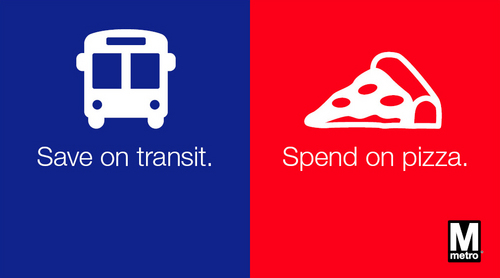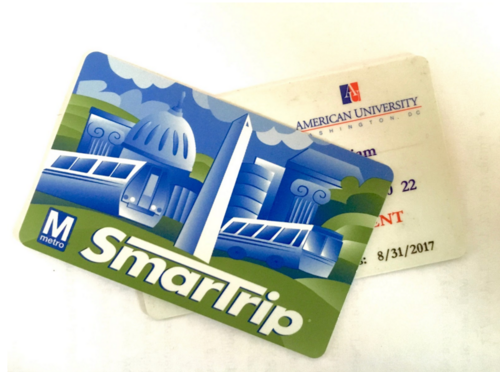
Back in December, WMATA and American University proposed a program that would allow students to pay a discounted rate for unlimited rides on both bus and rail. A student referendum and months of planning later, the pilot program is a reality. It launches this coming school year.
Called the “U•Pass,” the new pilot program reaches far more students than a previous effort between WMATA and American. Over 10,000 full-time undergrad, grad and law students at American will receive a SmarTrip card complete with a unique serial number and AU Logo. U•Pass will give holders unlimited rides on all bus and rail lines in the WMATA system.
Because American is on the hook for footing the bill, all full-time students will be enrolled, and an extra $130 per semester will be added to tuition to pay for the pass.
That increase in tuition will be worthwhile for most students given the benefits of the pass: WMATA has estimated that the average full-time student will save $1000 on transportation per school year. Additionally, since the cost of U•Pass is included in tuition, financial aid can cover the cost of the pass. Being able to pay for U•Pass through financial aid lifts a heavy burden for those who struggle to pay for Metro on top of college expenses to get to work or internships.
U•Pass will make it easier than ever for students to use Metro. The U•Pass is already paid for, creating the incentive to take the bus or train to campus instead of another service like Uber or Car2go. The savings combined with convenience will make it hard not to use Metro.
This partnership between WMATA and American solves the biggest dilemma previous pilots have failed to work out, and something WMATA struggles with in general: dedicated funding. WMATA has estimated that it will receive $2.7 million just this fiscal year from U•Pass sales.
Beyond the direct funding, WMATA is getting access to 10,000 students that may not have used the Metro system for their everyday needs before. A successful U•Pass program could lead to other universities doing something similar, and there’s a lot of potential in the hundreds of thousands of college students in DC.
All these potential riders are even more crucial because they are often off-peak riders. WMATA is looking for ways to not only increase ridership but to also even out ridership across the system from the current commuter pattern.
The students want this program
This past semester, American held a student referendum on the proposed U•Pass pilot and tuition increase. After two weeks of voting, an overwhelming 85% of the student body voted to approve the program.
Students are excited after hearing the news. A quick search of Twitter shows students asking the AU Office of Campus Life when and where they can pick up their new U•Pass. Students will pick up the pass during Welcome Week at many locations across campus, or can go to the Office of Parking and Traffic Services for late pickup.
It’s still just a pilot
The U•Pass Program is still a pilot, but it seems to be poised for success. As the program matures, and hopefully grows to more universities, WMATA and participating universities should look into expanding the program to other local jurisdictions. Currently, the U•Pass only works on WMATA, meaning students who use other systems such as Ride On or ART will need to have an additional SmarTrip to get around.
U•Pass will provide us with an opportunity to study the commuting patterns of students. Many bus lines run either through AU’s campus via Nebraska and Massachusetts Avenues or by AU’s Washington College of Law and satellite buildings on Wisconsin Ave. It will be interesting to see if the unlimited bus pass will translate into increased bus ridership in these areas.
The U•Pass pilot program is an exciting new option for AU students. Partnerships between WMATA and the area’s universities need to grow, and this pilot is a step in the right direction.

Five years ago, WMATA and American University teamed up to provide student SmarTrip cards, the goal being to eventually offer discounted student fares. But the program never expanded past its pilot. Will rekindling the effort mean more students on Metro?
During the pilot, American student ID information went on top of a blank SmarTrip card, allowing students to use the card on campus and on Metro. American and WMATA use the same companies to load money onto their cards, so combining wasn’t difficult.
Metro stations near colleges have higher off-peak ridership, an area where WMATA would be happy to boost numbers. Also, special college student passes have been successful in other public transportation systems, most notably in Chicago, where the Ventra UPass gives full-time students at over 40 schools in the area unlimited rides on CTA buses and trains.
The first effort ran into budget problems
The program started in 2010 with 20 of the combined cards going from the American student government to students and faculty. Eventually, the school distributed 300 cards. Combining the cards let AU students simplify their transit use by only having to load money onto one account, as well as see transit data and how much they were spending on fares.
The program’s goal was to eventually provide discounted student fares, and with the initial partnership working well, the student government started looking to make it happen.
Talks about discounted student fares and who would fund them began, but they didn’t go far. At the time, WMATA couldn’t give discounts to particular groups of customers due to its budget rules, meaning the AU student government would need to find a private source of funding for the discounts. Using the data gleaned from the pilot, the student government estimated the cost of the discounted fares to be around $300,000 a year. No one was willing to foot the bill, so the program never moved past the pilot phase.
WMATA and AU are giving it another try
The idea of special college passes has come up again in WMATA’s proposed FY 2017 budget, with AU once again working to pilot the program. If combined with some simple steps from universities, like putting bus route maps in freshman orientation packets, the move could greatly boost WMATA’s college student ridership.
College student passes with discounted fares would be an excellent way to incentivize public transit use for the estimated 225,000 college students in the DC region. WMATA needs more riders, even if they pay a discounted rate, to boost the bottom line. Colleges are a great place to find them.
Also, a renewed partnership will lead to fewer barriers to using Metro and Metrobus, which will benefit everyone. WMATA is even looking at providing combined SmarTrip and ID’s for MetroAccess patrons.
The new program might want to consider old ways
What’s on the table now is similar to the 2010 pilot program, but without the combined SmarTrip/ID aspect that made the 2010 program so useful. Instead, students will pay a monthly fee for unlimited rides rather than be able to add to their card as they go.
A college ID is a student’s key to their university, and a SmartTrip is a student’s key to the city— putting them together made a lot of sense. Having student Metro passes run through American ID’s would let students keep all their money in one place, and combining the two into one card would mean students would always have their SmarTrip on hand.

